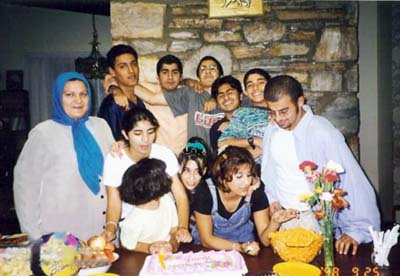Leila is the Youngest child of Rahim Kayukan. She was born in 1979, two years before his father, Rahim would leave the entire family behind to join the Mujahedin Khalq Organization, in September 1981. When Rahim left the family other siblings of Leila, Mozhgan, Mehran and Mosen were respectively, 13, 10 and 4 years old. At the time, their mother, Behjat Sediqi was 32 years old and since then she has never been contacted by her husband.

For four decades, Rahim Kayukan has been a member of the Mujahedin Khalq and is in the group’s camp in Albania now. He is one of the thousand Iranians who are kept under the cult-like structure of the Mujahedin Khalq. Rahim was a flight technician of the Iran National Airlines when he was recruited by the MEK. What has stopped Rahim from contacting his wife and children during these long years?
It may seem strange how intelligent people can get caught up in such a bizarre and dangerous cult like the MEK. But the fact is that cults target individuals throughout their life spans and across all socioeconomic groups and backgrounds.”Regrettably, it is impossible to quantify how many people are involved in potentially damaging cultic religions or similar ideological commitments,”Doni Whitsett & Stephen A. Kent assert in a paper on”Cults and Families”.
The authors of the article, referring to a large number of comprehensive books and researches on the issue, attempt to raise the awareness in ways that facilitate the ability of professionals to evaluate the impact of cults on some people who get trapped in these cults. They focus on both families within the cults and families outside of cults that are impacted by the cultic involvement of one or more of their members.
According to Whitsett and Kent,”A frequent consequence of cult involvement—and one that may have dramatic implications for diagnosis and treatment of former members—is the assault that these groups make upon family units among their adherents“. The evidence is officially published on the MEK-run websites from time to time, particularly after, each family member of the MEK adherents try to call on human rights bodies and file appeals against the MEK leaders.
In case of Leila Kayukan, her recent testimony in court made the MEK propaganda agents assault her family by accusing her of being dishonest about her father. This is an official position taken by the MEK vitrines in the social media which is exposed to the outside world. Not mentioning the way they treat members and their families inside the isolated camps of the Cult of Rajavi.

The authors of”Cults and Families”, believe that cult leaders use several factors to break the bonds between members and their families.”These factors include intensive resocialization into the new, deviant beliefs and behaviors; the demonization of people’s pre-cult lives; intense punishment and shaming regimes; restrictions on exogenous social contacts; heavy financial and time commitments; and constant demands to value group commitments over family considerations.”
According to the article, cult leaders impose various regressive techniques on their members that interfere with their ability to critically assess their situations. Authors also assert that the most virulent forms of regression.This kind of treatment demonstrate the disordered personalities of the cult leaders. however, probably reflect the disordered personalities of some leaders. They present several examples of cult leaders who suffer from various forms of psychological dysfunction.
“Many groups attack the formation of parent–child bonds by geographically separating children from their parents,”they state.”For example, various Eastern-based religious groups operate educational facilities back in their home countries, and often Western followers send their children to these overseas facilities for schooling. Consequently, children and parents see each other very infrequently, as distant strangers assume child-rearing and educational responsibilities. The children, therefore, cannot rely upon their parents in times of need.”
In addition to children like Leila and her siblings, there have been many children who were taken to the MEK camps by their parents but later on they were separated from them. then distanced from them. The number of children who have been separated from their parents by the MEK leaders mount to over 700. In just one cargo, over 300 children were separated from their parents in Camp Ashraf and were transferred via Jordan to Europe in 1990. The horrible fates of these children should be considered as cases of child and teen abuse.
Moreover,”similar threats to those directed against parent–child relationships also exist against spousal relationships”. The authors of the paper suggest,“In highly restrictive groups, strong marriages challenge leaders’ ability to control and receive the constant attention of the two partners. Moreover, couples are likely to establish private confidences—to share intimate feelings, dreams, desires, and perhaps doubts—all of which threaten paranoid leaders and evoke envy in those who have narcissistic and borderline personality disorders.”Therefore, forced divorces and mandatory celibacy in the MEK are definitely the sign of Massoud Rajavi’s personality disorders.
Thus, Rahim Kayukan and hundreds of his peers are trapped in the Cult of Rajavi. They are not allowed to talk and even think about their family. They are under daily pressure to denounce any relationship with the world except with the orders of the leaders Maryam and Massoud Rajavi. This is always mentioned in the testimonies of former members of the group and confirmed in the article too.
To download the video file click here
“Often groups require members to reveal their supposed deficiencies and shortcomings in assemblies, meetings, or other public settings,”Whitsett and Kent write.”Members, therefore, are trapped in double binds. On the one hand, if they go public with doubts or private opinions, then others will attack and possibly expel them. On the other hand, if they withhold their private (and possibly negative) thoughts, then they likely feel deceitful and inadequate to the tasks of their groups’ missions. Thus, many members are locked in inner battles between self-protection and group solidarity. Because they are torn in these ways, it is exceedingly difficult for them to provide emotional and cognitive guidance to children (not to mention to other adults).”
It is clear that, members of MEK have no way out of the Cult-like system of the group. They are certainly live cases of human rights violation that the International community is responsible to rescue them before irreparable damage is taking its toll.
Mazda Parsi


